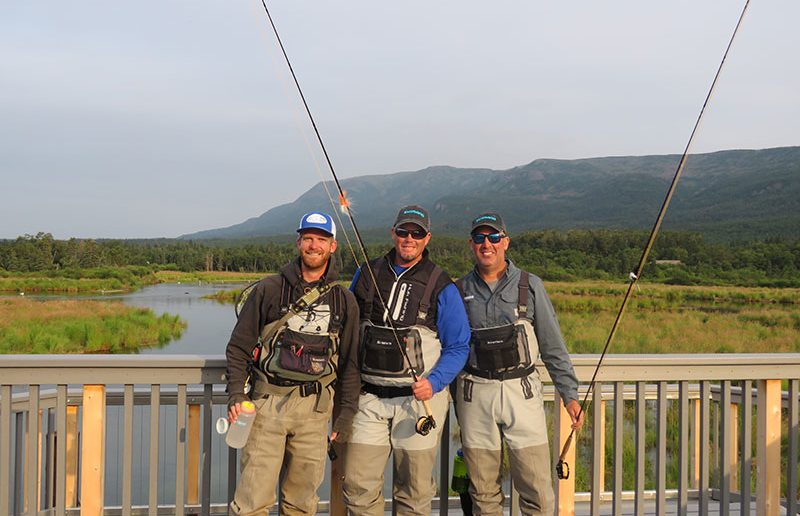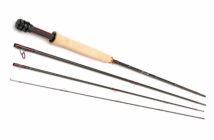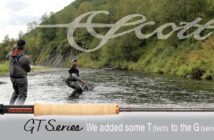
The Author (far right) not holding a spinning or casting rod.
By Pete Robbins
In September of 2015, my wife and I celebrated our anniversary at a ranch in Montana, and we scheduled a guided trip down the Bitterroot River as part of the week’s activities. We’ve both fished extensively, but had no experience with a fly rod, so upon our arrival we asked for a brief casting lesson the day before our float.
An older gentleman, no doubt tired from his just-concluded trip, met us at the pool and asked about our fishing experience. When he learned that we both fished frequently, but with conventional gear, he grumbled, “Oh crap. It would have been better if you’d never fished at all.”
Then he led us through a passionless 10 minute introduction, and took off before we could ask any questions or gather any feedback.
To be fair, our float the next day, with a different guide, turned out to be a fantastic experience. We caught plenty of cutthroats on dry flies, saw incredible scenery and while I’m sure our casts weren’t pretty, we gained some confidence by day’s end. As we trailered the raft in the afternoon, we looked at each other and agreed to go again two days hence.
While there was enough excitement to draw us back, the initial encounter left a bad taste in my mouth. It divided the universe into insiders and outsiders, a clearly-defined “us” and an overwhelming “them.” I see it in the bass fishing world where I work as well. Even though I’ve fished many of the great bass fisheries, often with the best tournament competitors alive, and know lots of folks on the “inside,” it’s still possible to feel like an outsider when put into a new setting. In just about any old-school tackle shop, there’s a group of insiders – they can be grizzled veterans or spit-shined young guns – who rule the roost. Walk in the door and if they acknowledge you at all it’s with a look of disdain. Our sport is built on secrets and hard-earned knowledge, and the natural tendency is to want to keep it a close hold. I’m guilty of this, too, quickly dismissing another angler’s questions at the gas station or the boat ramp. I’m not proud of it.
How can we hope to keep the sport alive and “done the right way” if we don’t act as stewards of the culture?
Heading into a recent trip to Alaska’s Bristol Bay region, I expected to be on the receiving end of such dismissals. The Bear Trail Lodge, on the Naknek River, is a fly angler’s paradise. Owner Nanci Morris Lyon holds a number of IGFA records, and their service and the fisheries around it attract the hard core anglers who dream of 30-inch rainbow trout and massive schools of wild-run salmon. While I’ve been to lodges from Africa to Brazil and all over the U.S., I’d never been to one dominated by fly anglers. While I fish approximately 70 days a year, my traveling partner hits at least 200 in a down year. Texas bass pro Keith Combs has won approximately $2 million dollars casting for cash across the country on the Bassmaster Elite Series and other tournament circuits. He’s won the prestigious Toyota Texas Bass Classic three times.
Nevertheless, my two days with a fly rod doubled his overall experience.
When we left Bear Trail Lodge, however, our two favorite days were not the ones when we caught big King, silver and chum salmon by trolling and casting with conventional gear. On the contrary, they were the two flyouts to Katmai National Park where we used 6-weight fly rods. Yes, the scenery had something to do with it, but so did the guides and the lodge. They made us realize the artistry and occasional competitive advantage of dipping a toe in their gear bin. By the time we got on the plane in Anchorage we were already planning a return (with our wives, who were more than a little peeved that they missed out), and resolved to go fly-only on the next trip.
Because I consult for an outfitter who has two largemouth bass lodges in Mexico, I started to think that maybe there’s a distinction between lodges, outfitters and guides who are welcoming to less-than-hard-core anglers, or anglers who have experience with other species, and those who are not. I tried to break down what the staff at Bear Trail Lodge did both to see why it worked, and to apply it to my own endeavors. Here’s what they did well that would keep me coming back.
Don’t Divide the World into “Us” and “Them”
The clientele at BTL during our stay included travel-the-world hard core fly anglers, occasional dabblers and people who’d never fished before, but distinctions based on those differences were not encouraged or enforced. On the contrary, everyone was invited to share their day’s experience, and indeed we found out about a flyout we wanted to do because two other “serious” fly anglers joined us for dinner and explained why it fit our skill set and goals. Additionally, unlike many lodges I’ve been to, the guides drank with us at the bar, ate with us each evening, and showed a general interest in our lives at home. That meant if I had a “stupid” question, I wasn’t as hesitant to bring it up and risk embarrassment.
Break Down the Mystery
Yes, I’ve fished a lot, but not for trout and salmon. The guides at BTL, most of whom had not fished for bass, showed interest in Keith’s career, and managed to relate our task at hand to things we understood. All fish relate to current. All fish spawn. All fish eat. All fish fear predators. If you tie on a fly without telling me what it represents, or how the tackle works as a system, I may catch a fish, but I won’t understand why. Don’t treat me like a dummy, but feel free to use simple terminology before introducing the jargon.
Offer Diversity of Personalities
BTL had female guides (indeed the lodge owner is female), along with Native Alaskans, young guides and older guides. I recognize that you can’t generalize – the burly tatted up dude with a mohawk may turn out to be a teddy bear, and the 98-pound would-be Disney Princess can be a drill sergeant on the water, but it takes a variety of personalities to make different customers feel comfortable. If you’re all crusty old dudes or trout-bum bros, you’re fighting an uphill battle.
If you’re a one-man show, that means you have to don multiple hats yourself. The client who needs discipline to succeed should get it, but the one who needs light encouragement, or a relatable anecdote, should get that, too. You can be yourself all the time without providing the same experience to everyone.
Offer Diversity of Experiences
Again, if you guide on a single fishery for a single species, this may be tough to do, but part of the appeal of BTL was the different waterways and different species that we chased – all five salmon, plus grayling, Dolly Vardens and rainbow trout. The rainbows were as fierce as advertised, and that’s what I’d want to concentrate on next time, but taking us different places required varying presentations, which aided the learning curve.
As with kids chasing bluegills in a pond, action itself may be the goal with beginners, while more advanced anglers might want a more technical approach or may be willing to exchange certainty for the chance at a trophy. Know thy customer.
Provide Quality Gear
A guided trip or a vacation at a lodge is not an expense to be taken lightly by most people. I have a garage full of tackle and a glitter boat with a price tag I’m embarrassed to admit, but if I’d had to tack on the cost of all of the gear necessary for an optimal stay at BTL it might’ve reduced my likelihood to go in the first place. I didn’t have waders, a fly rod, fly reel, lines or any of the other accoutrements necessary for success. What would it have cost to put that together? Several thousand, for sure, and I might never use it again. That would definitely dim my enthusiasm.
I know that the temptation is to give novices lower quality gear, but that’s a mistake. If you can convey to them the expense and fragility of such equipment, most people will treat it well. At BTL we were assigned a “wader locker” for our gear which made us take ownership of it. I still may not be familiar with all of the leading fly fishing brands, but now that I’ve used quality equipment, I’m more likely to gravitate to those brands, or at least explain to a fly shop owner what I liked about them. Any lodge owner, but particularly one who is sponsored by various companies, owes that to their business partners.
Let me Make Mistakes
This one goes back to “Break Down the Mystery.” OK, we’re catching lots of grayling and Dolly Vardens on egg imitations, but few of the rainbows we know reside in these same waters. Let’s try something else, even if it may sacrifice 30 minutes of valuable fishing time with no results. Explain why this alternative could produce. Let me re-learn the casting process for optimum presentations, even if it means some seriously awkward casts just when I was beginning to get semi-competent (albeit still appearing like a man swatting a bee in a phone booth with a golf club.).
Give me Feedback
Do you see a hitch in my casting motion that is hindering my offerings? Tell me in plain language how to fix it. Pick up the rod and show me if you have to. Do not yell. More importantly, if and when you see me doing something right, reward me at that moment. I’m not a puppy, but I respond to positive reinforcement much better than the sting of a shock collar. At the end of the day, take a few moments to informally tell me about the progress I made on the water and the next steps I should take to accelerate my improvement.
Show that You’re Invested in the Process and the Place
There’s nothing that says that a vagabond guide – in the Seychelles this month, then to Chile, then to Alaska, and back to New Zealand – can’t be a great guide, but if you want to build a dedicated clientele of all skill levels, it pays to be committed to the fishery at hand and to the sport. BTL owner Nanci Morris Lyon has guided in Alaska for several decades. She’s participated extensively in the Bristol Bay Guide Academy, a program that prepares young men and women for jobs on their home or nearby rivers, and stresses the importance of fly fishing. She’s also an outspoken leader in the fight against Pebble Mine. I’ve seen a similar mentality on a smaller scale at the Mexican bass lodges, where the commercial tilapia netters and the bass guides are often brothers, and have developed a regulatory structure that allows each to thrive and value the resource. If I’m going to return next year, it’s because I expect the fishing to be just as good as before – if not better.
The bottom line is that you have to resolve to treat every customer the same while at the same time treating every customer differently.
BTL’s attention to quality across the board while recognizing individuals’ differences led me to want to pick up a fly rod again in the near future. It made me want to go back to Bristol Bay, even though there are a wealth of other promising areas closer and cheaper. And it meant that I don’t even need to look at another lodge before I go. That’s a hell of a business plan, and a model for the industry.
Pete Robbins is a Senior Writer at Bassmaster Magazine and has blogged at Yamamoto’s Inside Line (www.insideline.net) since 2008. He’s a recovering tournament angler and a frustrated lawyer by day, with a penchant for turning three- and four-day weekends into distant fishing trips. He writes extensively about fishing, mostly about bass, and consistently touches on all aspects of the sport, from new tackle to tournament results to industry trends. He lives in Vienna, VA with his wife Hanna and his Australian Shepherd Rooster, and is addicted to high-end Japanese fishing tackle and the pegboard that it necessitates.




1 Comment
In my mind this is the only way the sport of fly fishing will grow. Over the years I’ve co-taught the Mini Course “Hooked on Fly Fishing” for the University of Wisconsin Extension to new prospective fly anglers some of whom were conventional anglers. And when I worked for a local outdoor/fly fishing shop, we frequently had a booth at the Madison Fishing Expo-a conventional tackle consumer and belt our booth around St. Croix rods-a brand that’s primarily conventional gear but also builds good fly rods and a brand these folks know and understand. Both. endeavors generated a lot of new business for the shop that we may not have otherwise gotten. It also helped that I, my co instructor, and shop employees weren’t arrogant condescending asses, and were able to relate to both genders from all walks of life and explain things in a way they could understand. We also gladly and patiently answered everybody’s “dumb questions”, and welcomed everyone to the group. I think fly fishing is only a small part of the fishing industry, and there’s a massive group of angling enthusiasts on the conventional side of the table that’s still a relatively untapped resource waiting to be converted to fly anglers. Think about it from the prospective of rifle hunting for deer vs. bow hunting for deer-you’re still hunting deer, just using a different method. Tthi creates better well-rounded sportsmen/women.